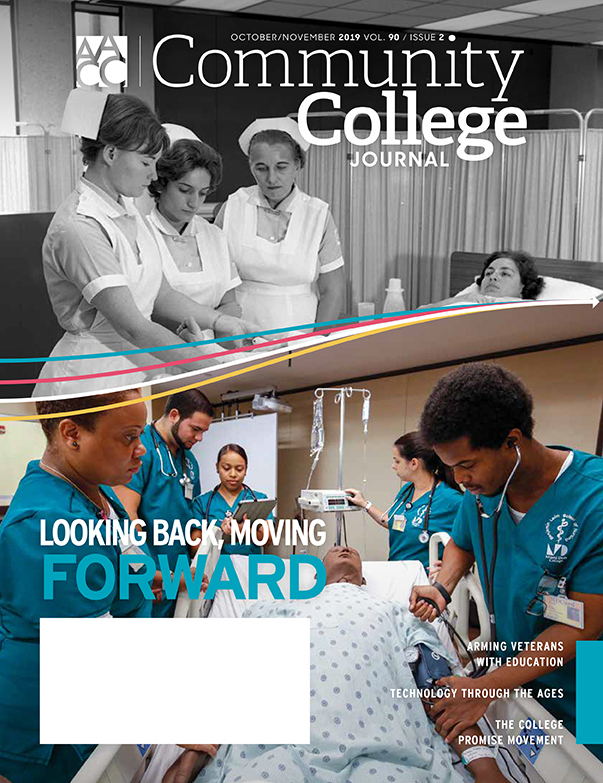Community colleges strive to fulfill the unique needs of military service members, veterans and their families, a mission harkening back to wartime and the decades in which the nation’s fighters were off the battlefield.
A December 1946 Community College Journal (then the Junior College Journal) column speaks to — in the era’s patriarchal language — the obligation two-year institutions had in assisting soldiers, sailors and Marines with the same fervor this population gave to our country.
This excerpt comes from an article in the new issue of AACC’s Community College Journal.
“(Military members deserve) security in an uncertain and unstable world; streamlined, effectual, vital teaching by broad-minded instructors; interested and humanized counseling; and orientation to civilian life embrace the fundamentals of what the veteran wants from school. He is entitled to them all,” the column states.
Educating the nation’s servicemen and women has long been a core undertaking of many community colleges, particularly in regions that host military bases and installations. Though the needs of student veterans and active-duty military learners have evolved, the commitment to this demographic from two-year colleges remains unwavering.
Easing the difficult transition
Tidewater Community College (TCC) is among the many institutions helping military personnel make the transition from war to work. At the cornerstone of this effort is the Center for Military and Veterans Education (CMVE), a self-described “one-stop shop” of resources tailored to armed service members, military spouses and dependents.
TCC draws on the massive military community of Hampton Roads, Virginia, with campuses in Chesapeake, Norfolk, Portsmouth and Virginia Beach. Out of 31,000 students enrolled, nearly one-third are military-related students (active duty, dependents and veterans) pursuing various career and technical programs, says Batanya Gipson, CMVE interim director.
At the center, integration back into civilian life is supported by a team of representatives — many with military experience — who navigate incoming students through a system they’ve been away from for years or even decades. Guidance could include filling out necessary forms or ensuring learners receive G.I. Bill benefits and other military-specific assistance in a timely fashion.
Additionally, center liaisons act as counselors pointing students to appropriate disciplines, including “applied science” programs that build on the skills veterans learned in uniform. The center also works with service organizations to address obstacles many veterans face either on active duty or upon returning home.
“Those barriers could be financial or personal; we want to address anything that might get in the way of a student’s success,” Gipson says. “Helping them be successful in the classroom may mean connecting them with resources that aren’t directly linked to education.”

There’s more in the October/November edition of Community College Journal.
Trouble with transitions
Adjusting to the classroom can be difficult for an older population used to a structured military environment, observers say. Nor is this problem a new one. In a March 1949 Community College Journal article, World War II veterans attending California’s Taft College chafed against the “immaturity” displayed on campus by their younger peers, while other military students simply could not handle the innate pressures of academia:
“They were limited in their scholastic preparation and abilities. The frustration which arose from failure to achieve academic success presented the veteran with a difficult problem. The following alternatives were open to him: drop school and go to work, change from an academic to a vocational program, or continue in an academic field,” the article states.
Whether serving in WWII, Vietnam or more recent conflicts, service members often feel like they don’t belong on campus, says Terence Nelson, coordinator of the Veterans Education & Transition Services (VETS) program at Saddleback College in Mission Viejo, California.
Saddleback’s approximately 1,470 military learners, who range in age from 22 to 30, don’t receive the same early intervention for higher education as their more traditional peers, Nelson says. Military personnel at Saddleback are provided guidance and scholarship assistance, along with outreach to a robust military community living and working at the nearby Camp Pendleton Marine Corps base.
The college also offers Boots-to-Books, an innovative introductory course that helps military-related students and their loved ones readjust to day-to-day life. Participants learn the same academic and interpersonal skills as a typical freshman, with a dose of psychological and transitional issues specific to the military mindset.
Creating a community
The son of a Navy corpsman and brother of a full-bird Army colonel, Nelson says a venue for community-building is a critical facet of Saddleback’s larger suite of services. Through a grant from the Orange County Veterans Initiative, Saddleback hosts fishing trips, paintball events and other activities designed to create a network among its military enrollees.
“That’s rare among community colleges, as most are commuter and transient in nature,” Nelson says. “We want to leverage relationships and build a support mechanism among peers. In higher education, we fulfill a role by providing support services, but those can be filled by peers, too. Peer-to-peer mentorship is a force multiplier.”

